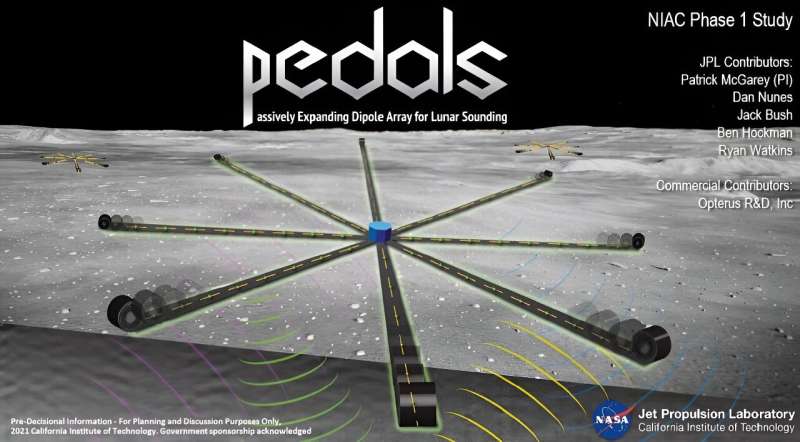Deploying a huge antenna on the moon could study its insides

Understanding what lies under the lunar surface could be critical to future exploration efforts. A series of missions have already mapped some parts of the sub-surface of the moon. Still, few have delved deep inside, where large lava caverns or potentially valuable water or mineral deposits may lie.
But that might be about to change. NASA's Institute for Advanced Concepts (NIAC) supplied funding to a novel technology developed by a team at its Jet Propulsion Laboratory (JPL) that could solve the long-standing problem of seeing what lies within the moon.
The project, the Passively Expanding Dipole Array for Lunar Sounding (or PEDALS), uses a self-deploying technique to position a large-scale antenna on the lunar surface. Once deployed, it can collect data on the lunar sub-surface down to a few kilometers, comparable with the deepest data we have ever collected.
Currently, the deepest data was collected by the Lunar Radar Sounder on the SELENE orbiter (better known as the Kayuga). However, it was intentionally crashed into the moon back in 2009, and, despite being able to monitor signals up to 5 km deep, it did not provide anything resembling a high-resolution image.
Other sounds, some of which date back as far as the later Apollo Missions, had a higher resolution but could reach the depth that would unlock a better understanding of the lunar surface's structure. A presentation created by the JPL team notes five scientific objectives that can be solved by PEDALS, ranging from mapping the 3D interfaces of volcanoes to understanding rock density in a particular area.
So just how would the system achieve those objectives? PEDALS would land using the time-honored tradition of falling to the surface in an airbag. Once there, it will deploy a coilable boom, a concept that has been the focus of several years of NASA research already. In theory, there's no actual constraint to the size of the boom PEDALS deploys, but the volume of the landing airbag and the surface area the antenna will need to cover will have an impact.
After deployment, PEDALS collects data using its antenna. What that antenna would look like remains a point of study, as the presentation details two potential configurations—a loop antenna or a coupled dipole. Both have advantages and disadvantages, but the JPL team needs to do more research to determine which would be more useful for the lunar use case.
One obvious question is—where could you deploy this thing? Passive viewing of the Apollo missions shows that the moon isn't particularly flat, and massive boulders are randomly strewn. Calculating the large rock sizes (they estimate 50 cm max diameter) and how much room they would need to deploy to a field with many times the area of the deployed antenna as a "free path," according to the JPL report.
That's not necessarily a deal breaker, as there are areas on the moon that meet the criteria—and maybe in a best-case scenario, they could get some help from an autonomous rover to move some of the rocks out of the way. But for now, the idea appears to be on hold, as it is unclear if PEDALS received a Phase II grant after being funded in 2021. However, it's likely that deploying a large-scale antenna to the lunar surface will someday get its day in the sun.
More information: PEDALS: Passively Expanding Dipole Array for Lunar Sounding, hdl.handle.net/2014/55805
Provided by Universe Today
No comments:
Post a Comment